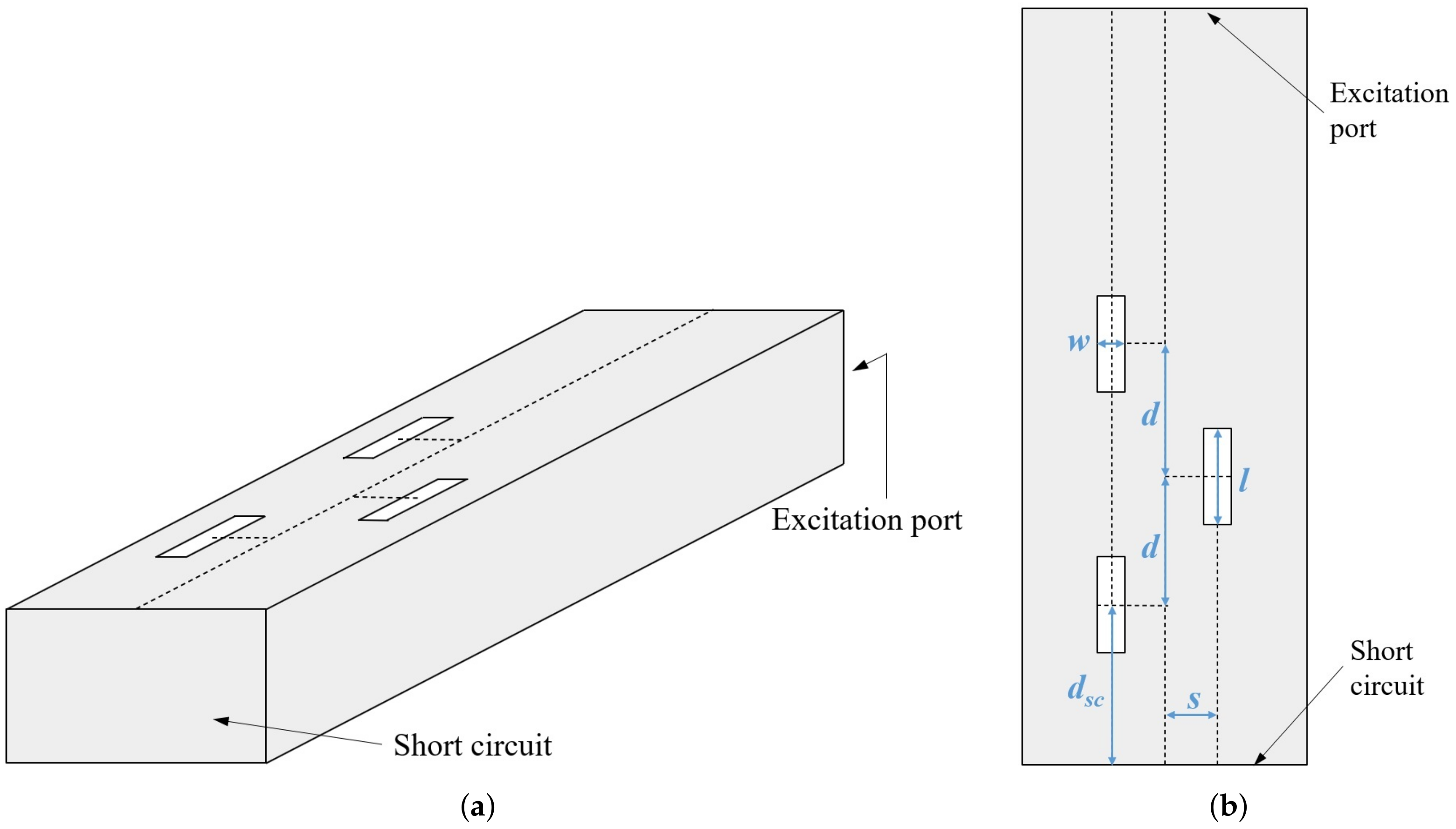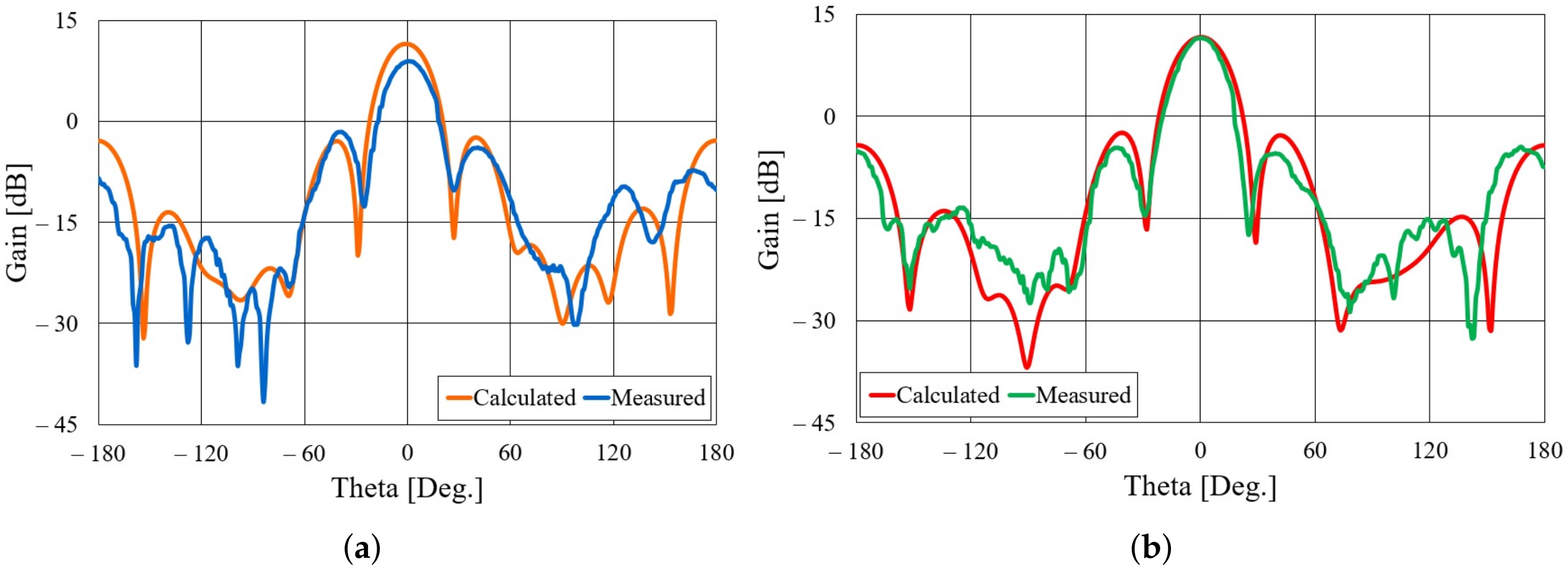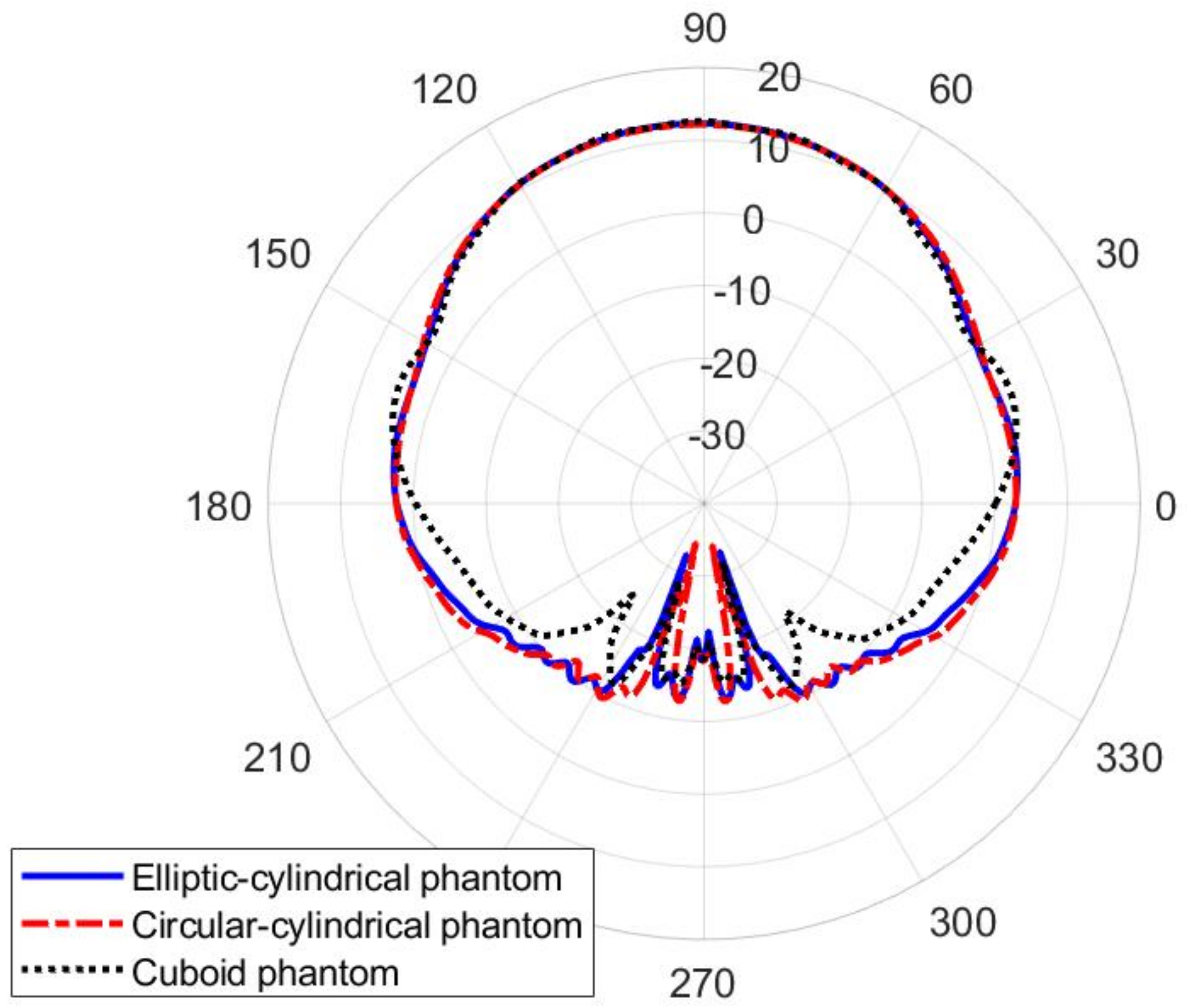Textile Slotted Waveguide Antennas for Body-Centric Applications
Abstract
:1. Introduction
2. Experimental Characterization of Textile Slotted Waveguide Antenna
- The antenna is manufactured from a rectangular waveguide capable of operating in the -GHz ISM band (thus the WG14 standard was selected);
- Central frequency of operation: GHz;
- dB in a bandwidth of at least 200 MHz or more;
- Rectangular waveguide slots with the length not exceeding half a wavelength and the width is much smaller than their length (Figure 1).
3. Antennas for Body-Centric Wireless Communications
3.1. Off-Body Communication
3.2. On-Body Communication
3.3. In-Body Communication
4. Conclusions
Author Contributions
Funding
Acknowledgments
Conflicts of Interest
References
- Jara, A.J. Wearable Internet: Powering Personal Devices with the Internet of Things Capabilities. In Proceedings of the 2014 International Conference on Identification, Information and Knowledge in the Internet of Things, Beijing, China, 17–18 October 2014. [Google Scholar]
- Henry, B.S.; Alsohaily, A.; Sousa, E.S. 5G is Real: Evaluating the Compliance of the 3GPP 5G New Radio System with the ITU IMT-2020 Requirements. IEEE Access 2020, 8, 42828–42840. [Google Scholar] [CrossRef]
- David, C.K.; Berndt, H. 6G Vision and Requirements: Is There Any Need for Beyond 5G? IEEE Veh. Technol. Mag. 2018, 13, 72–80. [Google Scholar] [CrossRef]
- Tataria, D.H.; Shafi, M.; Molisch, A.F.; Dohler, M.; Sjöland, H.; Tufvesson, F. 6G Wireless Systems: Vision, Requirements, Challenges, Insights, and Opportunities. Proc. IEEE 2021, 109, 1166–1199. [Google Scholar] [CrossRef]
- Hall, P.S.; Hao, Y. (Eds.) Antennas and Propagation for Body-Centric Wireless Communications; Artech House: Norwood, MA, USA, 2012. [Google Scholar]
- Roh, J.S.; Chi, Y.S.; Kang, T.J. Wearable textile antennas. Int. J. Fash. Des. Technol. Educ. 2010, 3, 135–153. [Google Scholar] [CrossRef]
- Paracha, K.N.; Rahim, S.K.A.; Soh, P.J.; Khalily, M. Wearable Antennas: A Review of Materials, Structures, and Innovative Features for Autonomous Communication and Sensing. IEEE Access 2019, 7, 56694–56712. [Google Scholar] [CrossRef]
- Mahmood, S.N.; Ishak, A.J.; Saeidi, T.; Alsariera, H.; Alani, S.; Ismail, A.; Soh, A. Recent Advances in Wearable Antenna Technologies: A Review. Prog. Electromagn. Res. B 2020, 89, 1–27. [Google Scholar] [CrossRef]
- Bonefačić, D.; Bartolić, J. Embroidered Textile Antennas: Influence of Moisture in Communication and Sensor Applications. Sensors 2021, 21, 3988. [Google Scholar] [CrossRef] [PubMed]
- Sehrai, D.A.; Asif, M.; Shah, W.A.; Khan, J.; Ullah, I.; Ibrar, M.; Jan, S.; Alibakhshikenari, M.; Falcone, F.; Limiti, E. Metasurface-Based Wideband MIMO Antenna for 5G Millimeter-Wave Systems. IEEE Access 2021, 9, 125348–125357. [Google Scholar] [CrossRef]
- Khalid, H.; Awan, W.A.; Hussain, M.; Fatima, A.; Ali, M.; Hussain, N.; Khan, S.; Alibakhshikenari, M.; Limiti, E. Design of an Integrated Sub-6 GHz and mmWave MIMO Antenna for 5G Handheld Devices. Appl. Sci. 2021, 11, 8331. [Google Scholar] [CrossRef]
- Means, D.L.; Chan, K.W. Evaluating Compliance with FCC Guidelines for Human Exposure to Radiofrequency Electromagnetic Fields; Federal Communications Commission: Washington, DC, USA, 2001. [Google Scholar]
- IEEE Standard C95.1-2019; IEEE Standard for Safety Levels with Respect to Human Exposure to Electric, Magnetic and Electromagnetic Fields, 0 Hz to 300 GHz. IEEE: Piscataway, NJ, USA, 2019.
- ICNIRP Guidelines for Limiting Exposure to Electromagnetic Fields (100 kHz TO 300 GHz). Health Phys. 2020, 118, 483–524. Available online: https://www.icnirp.org/cms/upload/publications/ICNIRPrfgd2020.pdf (accessed on 21 December 2021). [CrossRef] [PubMed]
- Ivsic, B.; Bonefacic, D.; Bartolic, J. Considerations on Embroidered Textile Antennas for Wearable Applications. IEEE Antennas Wirel. Propag. Lett. 2012, 11, 799–802. [Google Scholar] [CrossRef]
- Hirokawa, J.; Zhang, M. Waveguide Slot Array Antennas. In Handbook of Antenna Technologies; Chen, Z., Ed.; Springer: Singapore, 2016; pp. 1389–1413. [Google Scholar]
- Sanz-Izquierdo, G.B.; Wu, L.; Batchelor, J.C.; Young, P.R. Textile integrated waveguide slot antenna. In Proceedings of the 2010 IEEE Antennas and Propagation Society International Symposium, Toronto, ON, Canada, 11–17 July 2010. [Google Scholar]
- Lemey, H.S.; Rogier, H. Substrate integrated waveguide textile antennas as energy harvesting platforms. In Proceedings of the 2015 International Workshop on Antenna Technology (iWAT), Seoul, Korea, 4–6 March 2015. [Google Scholar]
- Lajevardi, M.E.; Kamyab, M. Ultraminiaturized metamaterial-inspired SIW textile antenna for off-body applications. IEEE Antennas Wirel. Propag. Lett. 2017, 16, 3155–3158. [Google Scholar] [CrossRef]
- Kokolia, M.; Raida, Z. AMC-Based Textile-Integrated Antenna. In Proceedings of the 23rd International Microwave and Radar Conference (MIKON), Warsaw, Poland, 5–8 October 2020. [Google Scholar]
- Kokolia, D.; Raida, Z. Textile-integrated microwave components based on artificial magnetic conductor. Int. J. Numer. Model. 2021, 34, e2864. [Google Scholar] [CrossRef]
- Shieldex® Nora Dell. Available online: https://www.shieldex.de/en/products/shieldex-nora-dell/ (accessed on 21 December 2021).
- Available online: https://www.shieldex.de/en/products_categories/fibers-yarns/ (accessed on 21 December 2021).
- Ivšić, B.; Šipuš, Z.; Bartolić, J.; Babić, J. Analysis of Safe Ultrawideband Human-Robot Communication in Automated Collaborative Warehouse. In Proceedings of the 14th European Conference on Antennas and Propagation (EuCAP 2020), Kopenhagen, Denmark, 15–20 March 2020. [Google Scholar]
- Saleh, A.A.M.; Rustako, A.J.; Roman, R.S. Distributed Antennas for Indoor Radio Communications. IEEE Trans. Commun. 1987, 35, 1245–1251. [Google Scholar] [CrossRef]
- Lea, A.; Hui, P.; Ollikainen, J.; Vaughan, R.G. Propagation between on-body antennas. IEEE Trans. Antennas Propag. 2009, 57, 3619–3627. [Google Scholar] [CrossRef]
- Ali, K.; Keshmiri, F.; Brizzi, A.; Hao, Y.; Craeye, C. Body area networks at radio frequencies: Creeping waves and antenna analysis. Comp. Rendus Phys. 2015, 16, 789–801. [Google Scholar] [CrossRef]
- Ivšić, B.; Bonefačić, D.; Šipuš, Z.; Bartolić, J. An Insight into Creeping Electromagnetic Waves around the Human Body. Wirel. Commun. Mob. Comput. 2017, 2017, 2510196. [Google Scholar] [CrossRef] [Green Version]
- Ito, K.; Lin, C.-H.; Lin, H.-Y. Evaluation of Wearable and Implantable Antennas with Human Phantoms. In Handbook of Antenna Technologies; Chen, Z., Ed.; Springer: Singapore, 2016; pp. 2239–2268. [Google Scholar]
- Radcliff, R.D.; Balanis, C.A. Modified propagation constant for nonuniform plane wave transmission through conducting media. IEEE Trans. Geosci. Remote. Sens. 1982, 20, 408–411. [Google Scholar] [CrossRef]

















| Textile | Aluminium | |
|---|---|---|
| Slot length l | mm | mm |
| Slot width w | mm | mm |
| Slot offset s | mm | mm |
| Slot spacing d | mm | mm |
| Distance from SC | mm | mm |
| First Slot | Second Slot | Third Slot | |
|---|---|---|---|
| Incident radiated power | % | % | % |
| Reflected radiated power | % | % | % |
| Total radiated power | % | % | % |
Publisher’s Note: MDPI stays neutral with regard to jurisdictional claims in published maps and institutional affiliations. |
© 2022 by the authors. Licensee MDPI, Basel, Switzerland. This article is an open access article distributed under the terms and conditions of the Creative Commons Attribution (CC BY) license (https://creativecommons.org/licenses/by/4.0/).
Share and Cite
Mikulić, D.; Šopp, E.; Bonefačić, D.; Šipuš, Z. Textile Slotted Waveguide Antennas for Body-Centric Applications. Sensors 2022, 22, 1046. https://doi.org/10.3390/s22031046
Mikulić D, Šopp E, Bonefačić D, Šipuš Z. Textile Slotted Waveguide Antennas for Body-Centric Applications. Sensors. 2022; 22(3):1046. https://doi.org/10.3390/s22031046
Chicago/Turabian StyleMikulić, Davorin, Evita Šopp, Davor Bonefačić, and Zvonimir Šipuš. 2022. "Textile Slotted Waveguide Antennas for Body-Centric Applications" Sensors 22, no. 3: 1046. https://doi.org/10.3390/s22031046
APA StyleMikulić, D., Šopp, E., Bonefačić, D., & Šipuš, Z. (2022). Textile Slotted Waveguide Antennas for Body-Centric Applications. Sensors, 22(3), 1046. https://doi.org/10.3390/s22031046








